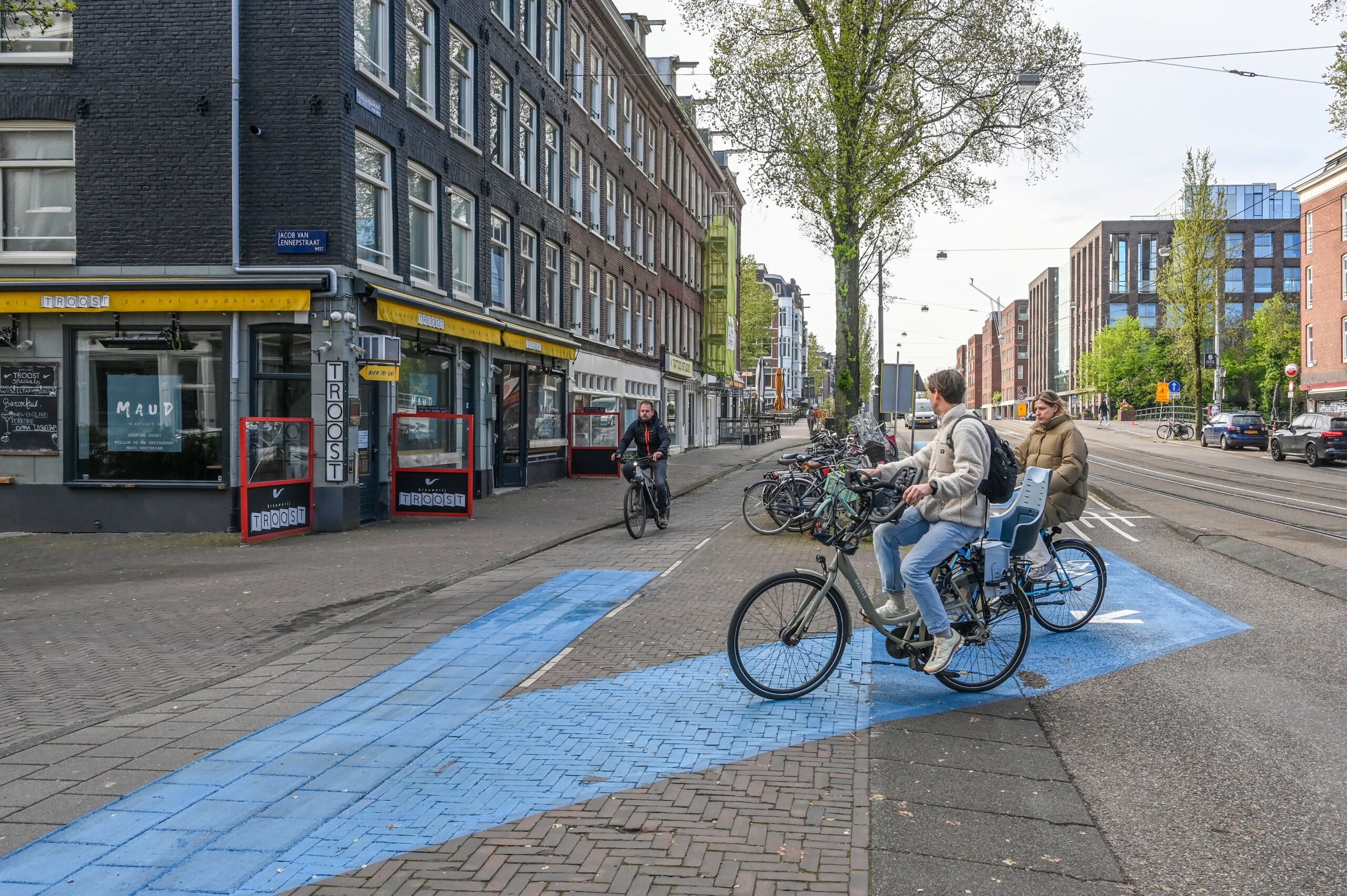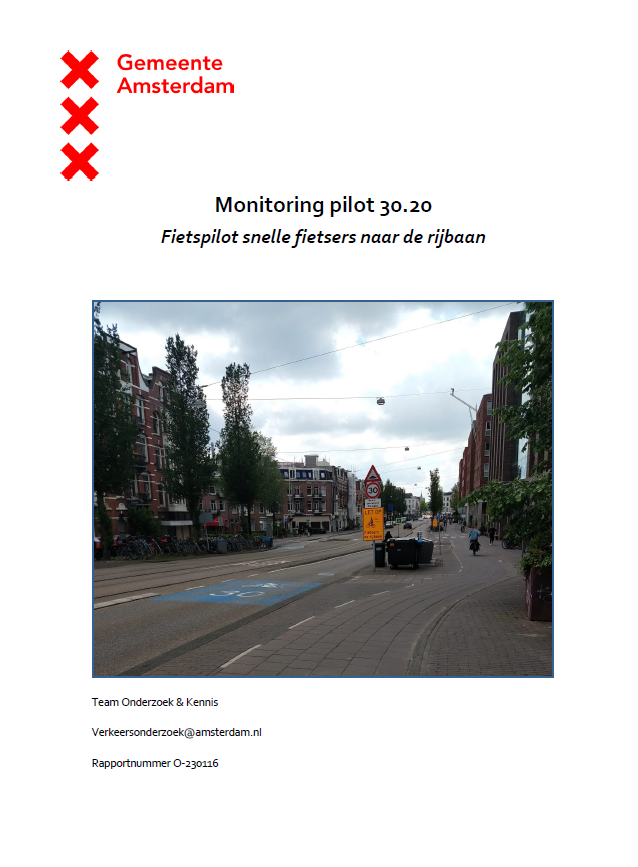Results of the trial to allow fast cyclists on the roadway
In 2022, Amsterdam Bike City organized a Bike Innovation Lab to find smart solutions for speed differences on cycle paths. Growing numbers of e-bikes, e-cargo bikes and fat bikes, lead to more differences in speed and mass between bicycles and unsafety on cycle paths. The winning idea of the Bicycle Innovation Lab has been carried out as a trial in which fast cyclists were allowed to ride on the roadway.
The results of the trial show that some of the (fast) cyclists actually used the roadway. Despite this limited effect, cyclists are positive about the trial.
There were 37 entries to the Bike Innovation Lab. Amsterdammer Wichert van Engelen was the winner with his idea to divide public space based on speed (30 km/h on the roadway, 20 km/h on the cycle path), instead of on vehicle type.
Purpose of the trial
The trial focused on the question whether a street layout in which fast (e-)cyclists may use the roadway will lead to more peace and safety on the cycle path.
There were three important questions:
- How do cyclists experience the new division by speed?
- Does the behaviour of cyclists change due to this layout?
- Does the new approach actually ensure a quieter and safer cycle path?
The effects of the trial were investigated with counting tubes on the road surface, observations of behaviour, interviews with cyclists and an online survey among all road users in the trial area, including motorists.
The measurements were carried out at three times, beforehand (baseline measurement) and twice during the trial (1- and 2- measurement).
Setup of the trial
The trial ran from April 18 to July 19, 2024 on a section of the Eerste Constantijn Huygensstraat and the Bilderdijkstraat in Amsterdam West.
This location was chosen for several reasons. There are many cyclists there (at least 15,000 per day), the cycle paths are relatively narrow. Car traffic isn’t too busy and with a maximum speed of 30 km/h the roadway is attractive for fast cyclists. Also, no road work had to be planned during the trial.
Cyclists had two options:
- Use the roadway, where the maximum speed is 30 km/h.
- Remain on the cycle path, with an advisory speed of 20 km/h.
NB: Although the maximum speed on the roadway is 30 km/h, electric bicycles may have motor power up to 25 km/h.
During the trial, the traffic situation was changed in this way:
- The mandatory cycle path was turned into a non-mandatory cycle path, so that cyclists were allowed on the roadway.
- As Dutch legislation doesn’t have a maximum speed on cycle paths, an advisory speed of 20 km/h was introduced for this non-mandatory cycle path. This speed is not included in the Traffic Regulations and was only possible with a temporary traffic measure.
- The places where fast cyclists went to and from the roadway were made recognisable with blue road markings to alert motorists and cyclists. This blue road marking was also only possible with a temporary traffic measure.
- Yellow signs were placed to make changes known to road users.
Results of the trial
The temporary street layout has caused a change in behaviour among some of the (fast) cyclists. This is evident from measurements with counting tubes on the cycle path and on the roadway. The counting tubes counted the number of cyclists and mopeds riding there, but could not distinguish between the two.

Numbers of mopeds plus cyclists on the cycle path (dark green) and on the roadway (light green), before (0-meting) and during the trial (1- and 2-meting).
The measurements show that during the trial there were more mopeds and cyclists on the roadway than before the trial. During the basement measurement, 12% of the traffic on the roadway was a (moped) bicycle. During the 1- and 2measurements this was resp. 14.4% and 15.1%. The higher percentage of mopeds and cyclists on the roadway is probably due to more (e-) cyclists on the roadway. Also, the percentage of mopeds and cyclists on the cycle path was lower during than before the trial.
Interviews show that (fast) cyclists chose the roadway because they could cycle faster there and they found riding there more pleasant than on the cycle path.
Due to the small numbers of cyclists that chose the roadway, the effects on the cycle path were small. The speed and the crowdedness there weren’t measurably lower. Reasons for cyclists to remain on the cycle path included safety, a preference for the cycle path, that they didn’t see other cyclists on the roadway, or that they thought their speed wasn’t appropriate.
More conclusions
- Motorists generally keep sufficient distance from (fast) cyclists on the roadway. No abrupt braking movements were observed.
- Motorists and cyclists take account of each other when cyclists merge onto the roadway and merge onto the cycle path.
- Cyclists who used the roadway during the trial rated cycling convenience more positively than before the trial.
- Despite the small effects, cyclists are positive about the trial and the idea of the trial for other places as well.

Follow-up
For the municipality of Amsterdam, it is important that cycle paths are safe for everyone. Therefor the municipality is investigating various options for improvements, such as this trial.
This trial could only be carried out with temporary traffic measures. To make the street layout of the trial permanently, adjustments to national regulations are required. Such as a maximum speed for cycle paths. In order to make further progress, the municipality shares the results of this trial with the Ministry of Infrastructure and Water Management and with other traffic organisations.
Other possibilities and developments
After this trial, the municipality is looking into the possibilities to join national pilots. Pilots to explore the usefulness, necessity and (legal) feasibility of existing legislation and the yet to be established national admission framework for Light Electric Vehicles (LEV’s).
These pilots are:
- Electric cargo bikes for freight transport voluntarily to the roadway where a maximum speed of 30 km/h applies
- Maximum speed of 20 km/h on a cycle path
- Ban on light electric vehicles (such as e-bikes) in pedestrian areas where cycling is permitted
Speed in parks
The municipality continues to investigate how to deal with the higher speeds of different types of e-bikes. This spring (2025), a campaign will start to reduce the speed of (e-)cyclists in parks. There, many people and activities come together, such as children playing, joggers, dog owners, walkers and cyclists. To ensure that everyone can move safely and pleasantly, the municipality wants to make cyclists aware of their speed.
Location
The city of Amsterdam
Interisting documents

Feb 18, 2025







